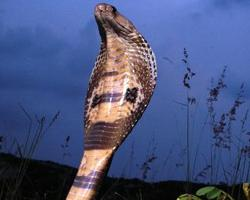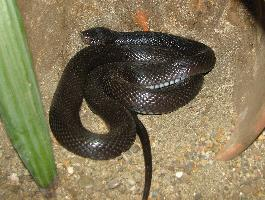
Greutăți și măsuri
| Lungime | de la 1 la 2,1 m |
|---|
Descrierea animalului
The Tiger snake (Notechis scutatus) is a highly venomous serpent that resides primarily in the southern regions of Australia, including its coastal islands, Tasmania, and parts of New South Wales and Victoria. This species is notorious for its potent venom, which makes it one of the most dangerous snakes in its habitat. Despite its name and reputation, the Tiger snake plays a critical role in the ecosystem, controlling rodent populations and thus contributing to the balance of nature.Physical Description:
Tiger snakes are robust and muscular, with an average length ranging from 1 to 1.5 meters, though some individuals can grow up to 2 meters. Their skin color and pattern vary significantly across their range, which has led to some confusion in their identification. Typically, their coloration can be olive, yellow, orange-brown, or jet-black, and many have banded patterns across their body resembling a tiger's stripes, hence their name. However, some individuals may lack this distinctive patterning, making them harder to identify. Their head is distinct and slightly broader than their neck, which aids in their hunting and feeding.
Habitat:
Tiger snakes are highly adaptable and can be found in a variety of habitats. They have a preference for wetter environments such as creeks, dams, and areas with dense vegetation which provide ample hiding spots and hunting grounds. However, they are also known to inhabit dry forests, grasslands, and even suburban areas where water bodies are present. Their adaptability to different environments has been a key factor in their survival and distribution.
Behavior:
Tiger snakes are solitary creatures, primarily active during the day (diurnal), although in hotter regions, they may exhibit more nocturnal behavior. They are excellent swimmers and can often be found near water bodies. During the colder months, Tiger snakes hibernate, seeking shelter in hollow logs, crevices, or burrows. They are known for their defensive behavior when threatened; flattening their bodies and raising their heads to appear more intimidating. If further provoked, they can deliver a swift and potentially fatal bite.
Diet:
The diet of the Tiger snake is varied and includes a wide range of prey. They feed on frogs, fish, lizards, birds, and small mammals. Their hunting method involves using venom to immobilize or kill their prey before consuming it whole. The potency of their venom allows them to tackle larger and more challenging prey.
Reproduction:
Tiger snakes are ovoviviparous, meaning they give birth to live young. Mating occurs in the warmer months, and after a gestation period, the female gives birth to a litter of 10 to 40 young. The juveniles are independent from birth and receive no parental care. They are born with a venomous bite and are capable of fending for themselves.
Conservation Status:
While not currently listed as endangered, Tiger snakes face threats from habitat destruction, roadkill, and persecution due to their venomous nature. Their presence in populated areas often leads to conflicts with humans. Education and awareness are crucial in conserving this species and minimizing negative interactions with people.
In conclusion, the Tiger snake (Notechis scutatus) is a fascinating and vital part of Australia's natural heritage. Despite their venomous reputation, they play an essential role in controlling pest populations and maintaining ecological balance. With increased understanding and respect for these remarkable reptiles, coexistence can be achieved, ensuring their survival for generations to come.
Animale similare
Fotografii noi cu animale
Top 10 animale
- Diana monkey (Cercopithecus diana)
- Dolphin gull (Leucophaeus scoresbii)
- Galápagos tortoise (Geochelone nigra complex)
- Moustached guenon (Cercopithecus cephus)
- Japanese spider crab (Macrocheira kaempferi)
- Colossal squid (Mesonychoteuthis hamiltoni)
- Fox tapeworm (Echinococcus multilocularis)
- Stone loach (Barbatula barbatula)
- Japanese macaque (Macaca fuscata)
- Barbary macaque (Macaca sylvanus)


